Burns Road Community Center to be vaccine center
UPDATE
A north county vaccination center run by the Health Care District is going to open Feb. 24 not at Palm Beach State College but instead at the Burns Road Community Center, the county announced Feb. 17.
The college location on PGA Boulevard didn’t work out because of space factors. The community center east of Military Trail on Burns is owned by the city of Palm Beach Gardens. It was “deemed more suitable for this type of operation,” the county’s press release said.
The Feb. 24 opening is based on vaccine availability. Vaccines will be given strictly by appointment.
At a Feb. 9 county commission meeting, County Administrator Verdenia Baker, prodded by Commissioner Maria Marino, said a center would be opening the following week at the college. But a final deal had not yet been struck.
ORIGINAL POSTING
Until now, north county residents had a choice of 15 nearby Publix stores to get vaccinated against the coronavirus.
That means signing up for the shots through the grocery chain’s hit-or-miss website.
But, by the end of next week, that could change.
Planning is under way for a site run by the Palm Beach County Health Care District to open at Palm Beach State College off of PGA Boulevard south of the Gardens Mall.
The news emerged Tuesday as County Commissioner Maria Marino, a former Gardens Council member who represents north county’s District 1 on the county commission, questioned county officials.
Pointing out that the average age in her district is 51, she said it was time north county had a site where residents could get inoculated.
County Administrator Verdenia Baker told her about plans for the college site. “We anticipate that site being ready to be up and running by the end of next week,” Baker said.
Marino had been pleading with county officials to offer vaccinations in north county. Lining up a site is a major first step.
“Opening up and having vaccines are two different things,” Marino said later in an interview. “We’ll be ready when we get more vaccines.
“It’s timing. And availability of doses. That’s the end of it. We can’t manufacture them out of thin air.”
First served at the site likely will be those already on the lengthy waiting list for a shot.
While difficulties getting an appointment coupled with the slow rollout of vaccines have grabbed headlines, health department figures indicate they’ve already inoculated about 46 percent of those over 65.
The site will be run by the Health Care District, which operates several COVID-19 testing sites, including the one at the FITTEAM Ballpark of the Palm Beaches in West Palm Beach. Officials will reach out to local fire-rescue departments for help.
That’s similar to the way the inoculation center opening Wednesday at the South Florida Fairgrounds is set to operate. It will be able to inoculate up to 7,000 people a day.
At this point, the only residents eligible for the COVID-19 vaccine are those 65 and older and front-line health care workers.
Residents who want a shot can’t just show up. They will need an appointment first. Details have not yet been announced on how that will be handled and whether those already on a waiting list will go first. But the waiting list will be tapped first at the fairgrounds, which is off Southern Boulevard west of Florida’s Turnpike.
Thank you for reading. You may also want to check out Joel’s recent PBGWatch blog on the proposed PGA Station development and the return of developer Dan Catalfumo. Joel wrote and edited stories at The Palm Beach Post for nearly 30 years before departing in December 2020. He lives in Palm Beach Gardens and welcomes your comments and news tips at JoelOnGardens@gmail.com.
Out of retirement and into the frying pan — developer Dan Catalfumo is back
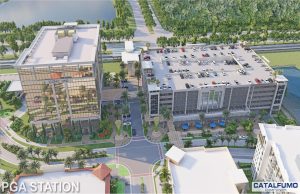
An “iconic” eight-story office building, left, and 1,066-space parking garage along with a 396-unit apartment building, right at bottom, and adjoining garage are proposed by developer Dan Catalfumo southwest of PGA Boulevard and Alternate A1A. (Courtesy Dan Catalfumo and SPINAOROURKE + Partners of West Palm Beach)
Palm Beach Gardens developer Dan Catalfumo is back.
When last we saw him 10 years ago, the city’s most influential builder since John D. MacArthur had been stripped of his real estate empire under a mountain of debt.
He invested in a chicken deboning business and manufactured a seatless bicycle. He was spending time away from Palm Beach Gardens at second homes in South Carolina and Costa Rica.
Now, he’s pitching a $200 million legacy project in Palm Beach Gardens.
He wants to build up to 750 apartments and an “iconic” eight-story office building on land he initially developed but lost to foreclosure.
He no longer has the 350-employee workforce that made him the county’s biggest builder or the portfolio of developable properties that made him central to Palm Beach Gardens’ future.
But he’s positioned to leave his mark with an ambitious proposal called PGA Station that would refashion an underused center into a major hub on the city’s most prominent commercial artery.
“This,” he said, “should be our legacy for 50 years to come.”
Retirement, said Catalfumo, 65, did not suit him.
“I was bored. I didn’t have anything to do. I don’t play golf. So …”
So, in April 2019, Catalfumo brought $17 million to the table, with construction partner and longtime friend Bob Rawe, to buy three properties from BBX Capital Asset Management, the same lender that won a $44 million foreclosure judgment against Catalfumo just eight years earlier.
The BBX debt and others, once totaling more than $100 million, are long gone, Catalfumo said, a statement reflected in court records.
“You write them a check, they go away,” he said. “Every person was paid 100 cents on the dollar. My mom and dad gave me a clean name when I was born and I have a clean, spotless name still. I owe nobody a penny. I wrote the checks to satisfy everyone. It did not change my lifestyle. Pour the wine, I drink.”
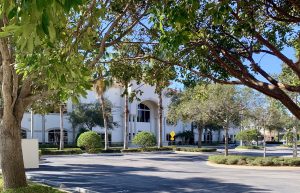
The Robb & Stucky building in the former PGA Design Center is slated for the wrecking ball as part of Dan Catalfumo’s proposed PGA Station. (Joel Engelhardt photo)
‘Iconic’ offices
With the land buy, Catalfumo took a commanding role in the revival of a mostly vacant and forgotten 30-acre corner of Palm Beach Gardens known as the PGA Design Center.
Erected in 2004 on former MacArthur Foundation land, the design center just west of Legacy Place and south of PGA Boulevard gave space to the booming furniture industry during a seemingly endless real estate expansion.
While the La-Z-Boy showroom off of RCA Boulevard remains, the huge two-story Robb & Stucky showroom is destined for the wrecking ball. The building, vacant for 10 years, would make way for a 396-unit apartment building, with the potential to go up to 750 units, and a 608-space parking garage.
Catalfumo is partnering with the Richman Group, which has built apartment complexes throughout Florida and has an office in West Palm Beach, to build the residential.
But the centerpiece of Catalfumo’s plan submitted to the city in September is the 200,000-square-foot office building on the vacant 7 acres along the railroad tracks at the foot of Design Center Way. It would include a 1,066-space parking garage with 100 spaces set aside for Tri-Rail if it comes.
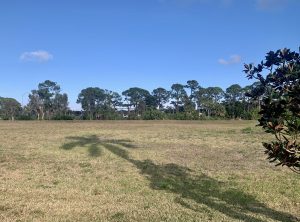
The office site is along the railroad tracks in developer Dan Catalfumo’s proposed PGA Station. (Joel Engelhardt photo)
Catalfumo in consultation with Tri-Rail is proposing to build walkways and drop off areas to serve the proposed train station separately from the entry to the office building.
He promises a Class A building with interiors undisturbed by columns, allowing for open, 25,000-square-foot floor plans.
He also would retrofit an existing two-story, 20,400-square-foot building, formerly home to Robb & Stucky’s outdoor collection, where he has rehung the Catalfumo nameplate.
Gone will be the Mediterranean-style architecture of the existing buildings. The new buildings, Catalfumo promised, will be “clean and crisp.”
The architect for the office building, SPINAOROURKE + Partners of West Palm Beach, describes it this way in Catalfumo’s application to the city:
“The project’s architectural style is Contemporary modern. The overall project design is straightforward in its layout and the style reflects that with clean crisp forms derived from the simple massing.”
Catalfumo expects to bring the project before the city’s Planning, Zoning and Appeals Board in two months, however the city has not yet scheduled a hearing. City Council review would follow.
While commuter rail in north county is still years away, the city encourages apartments near the rail line to generate density within walking distance of the proposed train station.
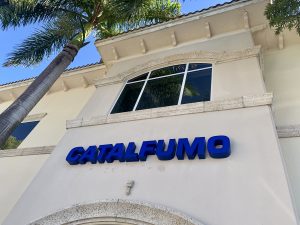
Developer Dan Catalfumo has set up offices in the former Robb & Stucky outdoor furniture center at the center of his proposed PGA Station development. (Joel Engelhardt photo)
The proposal initially calls for 396 units, which is 13.4 units per acre. With bonuses for workforce housing, environmentally friendly design and ground-floor retail, Catalfumo is seeking to ultimately be allowed to build 25 units per acre over the 30-acre site, or 750 units.
He is seeking five waivers, including 48 fewer residential parking spaces, saying shared parking with the office parking garage and existing parking will make up for it. Two waivers would let him erect more signs on his buildings than allowed and two would allow landscape reductions, in one case to accommodate the train station.
The Robb & Stucky demolition would happen first, followed by construction of the apartment building. The office building would come later.
Owned the heart of the Gardens
While Catalfumo has been behind many large and important buildings throughout Palm Beach County — such as Office Depot’s Delray Beach expansion, West Palm Beach City Hall and adjoining library and the Port of Palm Beach cruise terminal — he has had more impact on Palm Beach Gardens then anywhere else.
Twenty years after the death of the city’s founder, insurance magnate John D. MacArthur, Catalfumo took up the mantle to shape all four corners along what is arguably the city’s most important intersection, the crossing of PGA Boulevard at Alternate A1A near the Gardens Mall.
He spent about $50 million to buy large undeveloped sites on all four corners in 1999, when MacArthur’s Chicago-based foundation sold off its 14,808 acres, much of it centered in Palm Beach Gardens and held off the market for years after MacArthur’s 1978 death.
And until the Great Recession of 2008 hit, Catalfumo made money selling or developing the land.
First came the PGA flyover, allowing PGA to flow over the Florida East Coast Railway tracks and Alternate A1A, a $26 million state construction project cleared only after the state agreed to pay the MacArthur Foundation $12 million for 35 acres needed for drainage and right of way.
Then Catalfumo began marketing the four corners around it, properties that would grow into Downtown at the Gardens, Legacy Place, the Design Center and a Florida Power & Light campus.
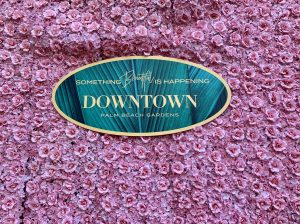
Downtown Palm Beach Gardens, originally known as Downtown at the Gardens, grew out of MacArthur Foundation land bought by Dan Catalfumo. (Joel Engelhardt photo)
Catalfumo’s $10 million investment in what would become Downtown at the Gardens and a hotel nearly doubled in value when he sold them in 2002 and 2003 for a combined $19.3 million, deeds show. He spent $15.2 million on PGA Boulevard sites on the east side of the mall, bringing in at least $26 million.
He paid $12.9 million for land that became Legacy Place, selling off one portion for a 382-unit apartment complex for $6.7 million in 2002 and, two years later, the commercial section for $25.3 million, records show.
He paid $4.5 million for the 30-acre Design Center site south of PGA and west of Alternate A1A and began selling parcels in 2007, including one for his corporate headquarters. The northern portion of the site began to take shape with $9 million in sales in 2008, just as the economy began its collapse.
In 2011, a circuit court judge ruled he owed BankAtlantic $44 million for loans against the property. A successor bank, BBX, pursued the case vigorously, saying in court papers that Catalfumo had transferred millions to a Cayman Islands bank account. In a June 2013 press release, BBX said Catalfumo agreed to settle for $25 million upfront, $5 million later and forfeited property valued at $14 million.

Perkins + Will of Coral Gables designed this aerodynamic six-story office building for FPL. It is rising just west of the Gardens Mall on Kyoto Gardens Drive.
“I paid CASH 100% on the dollar,” Catalfumo said.
Lenders also seized the fourth corner, the future FPL site, where Catalfumo confirmed that he had squirreled away a 4.25-acre parcel under the name Spearfisher Partners. The lender sold the rest of the 86-acre site to FPL in 2011. But Catalfumo held on to his piece until March 2018, when FPL paid $4.89 million for it.
In 2019, years after the lender lawsuits were closed out, Catalfumo paid cash when he bought three key Design Center properties back for $17 million. On the day of the closing, BBX extended him and partner Bob Rawe a $4.6 million loan, mortgage records show.
He and Rawe quickly built the second building in the center for TBC Corp., dubbed TBC South, a 60,000-square-foot office building at 4260 Design Center Drive.
That left two parcels, one containing the long-vacant Robb & Stucky buildings, the other a blank slate along the railroad tracks.
Now with five employees including his 26-year-old son, not 350 workers as in the past, Dan Catalfumo is moving forward on what he calls his legacy.
“This is full-time. Fourteen hours a day,” he said. “This is the new wave of the future.”
Thank you for reading. You may also want to check out Joel’s recent PBGWatch posting on the status of plans for a Tri-Rail commuter line in north county. Joel wrote and edited stories at The Palm Beach Post for nearly 30 years before departing in December 2020. He lives in Palm Beach Gardens and welcomes your comments and news tips at JoelOnGardens@gmail.com.
All track, no train. What will it take to get Tri-Rail to north county?
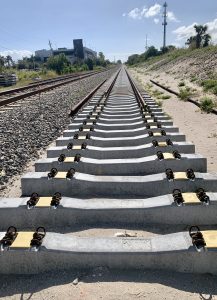
A second set of tracks lies next to the existing Florida East Coast Railway tracks on Jan. 29 just south of Richard Road and west of Alternate A1A in Palm Beach Gardens. The Brightline passenger rail service is double-tracking the FEC line from West Palm Beach to Cocoa as part of its $2.7 billion plan to provide Miami-to-Orlando service in 2023. (Joel Engelhardt photo)
For the first time since its inception in 1989, Tri-Rail is physically able to run its trains from Miami all the way through Palm Beach Gardens to Jupiter.
Officials have been looking forward to this moment for decades to make good on a promise of delivering commuter rail to north county.
But there’s still a big hurdle in making a short-stop coastal commuter rail service real: Money. Lots of it. In fact, the rail line is still hundreds of millions of dollars away from actually delivering.
That hasn’t stopped transportation advocates from pushing the link. They’re encouraged by two recent developments: the double-tracking happening now on the easternmost Florida East Coast Railway tracks, courtesy of the long-haul passenger service Brightline, and the recent completion of a $4.2 million crossover in West Palm Beach to let Tri-Rail trains switch seamlessly from the CSX rail line to the FEC.
The FEC is the easternmost line that, unlike CSX, rolls right through north county cities and towns.
Two hurdles could derail this north county expansion: The rail service doesn’t have permission from Brightline to operate on the FEC tracks and Palm Beach County has not begun negotiating a price.
And, more critically, local officials haven’t figured out how to pay for the rest of the project, particularly new stations and new sidings at a price of more than $100 million.
Oh, and the cost to actually run the trains could be as high as $19 million a year, a figure fares alone will not cover.
Until these issues are resolved, the hop-on-board support needed to spend taxpayer money in such a big way can’t leave the station.
A steering committee assigned to the task last met in February 2018 before acknowledging the difficulty of overcoming those unresolved issues and shutting down. The panel’s final instruction to staff went nowhere: No north county cities stepped up to agree in writing to offer “local funding options,” although Palm Beach Gardens has approved a mobility fee.
But the issue popped up again at a meeting Jan. 21, when the chief of the Florida Department of Transportation in Fort Lauderdale, Gerry O’Reilly, responded to a question from Palm Beach County Commissioner Robert Weinroth. He said preliminary planning for the Tri-Rail Coastal Link is on hold because local officials haven’t lined up ways to pay for the project.
“This project has advanced through all the stages it needs to. Now it needs entities to say they would pay the costs of the train. Dade and Broward have done that,” O’Reilly told Weinroth at a meeting of the county’s Transportation Planning Agency. “You need to decide if someone in Palm Beach County is going to pay for the operating fee.”
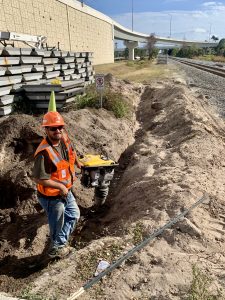
A worker digs a trench Jan. 31 to prepare for the upcoming double-tracking of the Florida East Coast Railway line at Kyoto Gardens Drive in Palm Beach Gardens, just west of the Gardens Mall. (Joel Engelhardt photo)
Brightline ready to deal
If O’Reilly and other advocates had their way, Palm Beach County officials would step up as their southern counterparts did. Voters in both Broward and Miami-Dade have approved sales tax hikes to pay for transportation projects.
Some of that money could cover the huge costs of offering commuter train service on the FEC line.
Such a tax in Palm Beach County likely would have to get voter approval and await the expiration around 2026 of the county’s current sales tax “surcharge,” an extra penny on every dollar, which raises the county’s sales tax to 7 percent.
Costs could better come into focus as Brightline for the first time has expressed interest in sharing its coastal tracks with a short-haul commuter line.
For a price.
In November, Miami-Dade County agreed to negotiate a contract paying Brightline up to $50 million and $12 million a year for 30 years for the right to run commuter trains on the FEC corridor. A final agreement remains to be negotiated.
Broward is next. But talks about access between Brightline, which suspended its nascent Miami-to-West Palm Beach service after COVID struck, and Palm Beach County haven’t begun.
While Broward, Dade and the southern half of Palm Beach County already have Tri-Rail, its tracks are west of most downtowns. The state paid $264 million in 1988 to buy the tracks, which also carry Amtrak and freight trains, and later spent $300 million over 10 years to double-track the 71-mile corridor.
But it’s just not enough to serve the core population living closer to the coast.
While Tri-Rail is on pace to record its 100-millionth rider in August, it envisions luring more passengers if trains stop in the center of a downtown, a high-stakes move to a different rail corridor talked about since the early 1990s.
“The last mile is often a challenge for commuter rail,” said Steven Abrams, a former Palm Beach County commissioner and Boca mayor who runs Tri-Rail’s South Florida Regional Transportation Authority. “The last mile is less of a challenge when where you’re going is within walking distance of the station.”
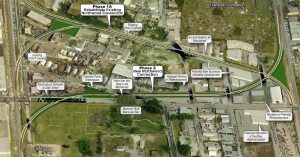
Map provided by Tri-Rail shows the connections both for northbound and southbound trains at 25th Street in West Palm Beach. Work on the $4.2 million project was completed in late 2019, providing an historic opportunity to run Tri-Rail trains into Riviera Beach, Palm Beach Gardens and Jupiter.
25th Street connector
There are two ways to get commuter rail to north county.
Trains could run from Miami north on the FEC line. Or passenger cars could switch from Tri-Rail’s CSX tracks to Brightline’s FEC tracks at 25th Street in West Palm Beach.
The link is between Tri-Rail’s two most northern stations, the downtown West Palm station on Tamarind Avenue and the Mangonia Park station, next to the vacant jai-alai fronton on 45th Street.
After Mangonia, the CSX line veers to the west toward Indiantown in Martin County. The FEC, built by Henry Flagler more than 100 years ago, continues up the Florida coast to Jacksonville.
The 25th Street connection became reality in 2019 after a federal grant paid for Tri-Rail and FDOT to build the half-mile link between Australian Avenue and U.S. 1.
At one time, officials considered — and rejected — building the connection in the heart of downtown West Palm Beach.
The only other FEC/CSX connection is at 79th Street in Hialeah. A third connection is planned for Pompano Beach.
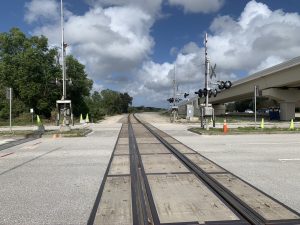
The Florida East Coast Railway tracks cross Kyoto Gardens Drive just west of the Gardens Mall in Palm Beach Gardens on Jan. 31. (Joel Engelhardt photo)
All on board for $100 million?
Switching Tri-Rail trains from the CSX line to the FEC at 25th Street could bring commuter rail into north county for the first time since passenger service stopped in the 1960s.
But at what cost?
The steering committee, which brought together regional transportation planners and elected officials, spelled out the potential costs in 2018, based on 2014 calculations adjusted for inflation.
They considered five north county stations: 45th Street in West Palm Beach, 13th Street in Riviera Beach, Park Avenue in Lake Park, PGA Boulevard in Palm Beach Gardens and Toney Penna Drive in Jupiter.
They anticipated spending nearly $13 million to buy the land for stations and parking and $35 million to build the stations.
Another $59 million would go toward installing extra tracks around the stations to allow Brightline and freight traffic to pass as passengers got off and on the trains.
That’s $107 million just to get rolling — without a payment to Brightline for the rail line.
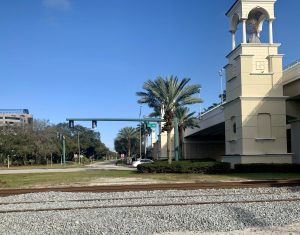
Rails line up next to the Florida East Coast Railway tracks just north of PGA Boulevard (elevated at right) along Alternate A1A in Palm Beach Gardens. (Joel Engelhardt photo)
While officials put the cost of a locomotive and three train cars at $17 million, they figured Tri-Rail would use its existing trains to spare that expense.
Running 50 trains every weekday, presumably under Tri-Rail, will cost another $12 million to $19 million a year.
Subsidies are required because riders aren’t going to immediately flock to the trains, meaning fares won’t cover costs.
While most of the money likely would come from federal or state sources, powered by taxpayers, the local match could be as much as 40 percent, officials said.
Sales and property taxes and utility fees could be tapped, as could the property tax on rising land values due to denser development near stations.
No decisions were reached and no city has volunteered to commit.
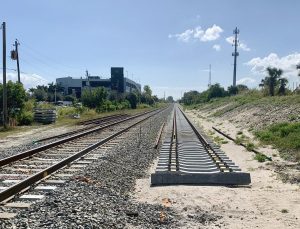
A second set of tracks lies next to the existing FEC tracks on Jan. 29 just south of Richard Road and west of Alternate A1A in Palm Beach Gardens. (Joel Engelhardt photo)
Why bother?
Local officials have to contend with a natural skepticism toward paying for a service that may never pay for itself. Heeding advice that trains are needed now, to prepare for inevitable gridlock on the regional road network, is a hard sell.
As Abrams pointed out, “Four hundred cars equal eight buses equal one train.”
Many residents oppose commuter service because, with up to 50 trains a day going back and forth, it will mean more frequent waits on east-west roads for rail gates to lift. They also object to the blare of train horns, although steps are promised to create “quiet zones,” as achieved with Brightline from Boca to West Palm.
The consequences, as Brightline encountered, could well be a rising number of people stepping in front of quiet, fast-moving trains.
And, has been the case for decades, many residents balk at paying hundreds of millions of dollars to subsidize transportation for thousands.
Supporters say the government already pays billions to subsidize roads that will be so overwhelmed by traffic that investing in trains now will appear visionary 50 years out.
Reducing reliance on cars is a huge help for the environment, they say, and opening up land near tracks to take advantage of rail is big business. A 2013 study for Tri-Rail said the Coastal Link could generate $1.4 billion in new development, including 5,500 residential units and 8 million square feet of commercial.
Brightline construction half-done
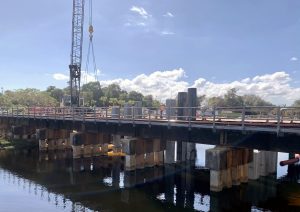
The railroad bridge over the Earman River in Palm Beach Gardens, also called the C-17 Canal, is one of 29 bridges being rebuilt by the Brightline passenger rail service as it adds a second set of tracks along the FEC Railway between West Palm Beach and Cocoa. The bridge, pictured here on Jan. 29, is just west of Alternate A1A and north of Northlake Boulevard. (Joel Engelhardt photo)
Meanwhile, Brightline, a privately owned company, is halfway done with its $2.7 billion expansion from West Palm Beach to Orlando, spokeswoman Katie Mitner told the Treasure Coast Regional Planning Council on Jan. 15. Completion is expected in 2023.
While Brightline began operating passenger trains in January 2018 between West Palm Beach and Miami, it suspended service in March 2020 because of the COVID-19 outbreak.
While often referred to as high-speed rail, Brightline trains can reach a top speed of 79 mph on the Miami-to-West-Palm section and up to 110 mph farther north. High-speed rail is generally considered to start at 160 mph.
After searing criticism over Brightline’s decision to build coastal stations only in Miami, Fort Lauderdale and West Palm Beach, the rail service has committed to adding stations in PortMiami, Aventura and Boca Raton. Additionally, Brightline has announced plans to add one station each on the Treasure Coast and the Space Coast.
To get to Orlando, the company must first add a second set of tracks north of West Palm, a step already completed to the south. The road closures at rail crossings in north county are part of upgrades to the 135-mile section to Cocoa.
Brightline also is laying tracks from Cocoa to Orlando International Airport, a distance of about 35 miles. Ultimately, Brightline expects to expand to Tampa.
Most recently, Brightline reopened the Donald Ross Road intersection at Alternate A1A after installing double tracks. Next in north county is Center Street at Alternate A1A in Jupiter, starting in February.
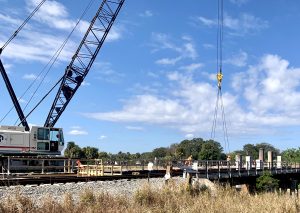
The railroad bridge over the Earman River in Palm Beach Gardens just west of Alternate A1A and north of Northlake Boulevard. (Joel Engelhardt photo)
The work calls for Brightline to rebuild 29 bridges along the FEC line, including the rail bridge over the Earman River north of Northlake Boulevard and west of Alternate A1A in Palm Beach Gardens.
The Loxahatchee River rail bridge in Jupiter also will be rebuilt.
While Brightline’s parent company no longer owns the tracks, it has taken the lead in negotiating agreements with South Florida counties for the rights to share the tracks. Grupo Mexico, a mining and rail conglomerate, paid $2.1 billion in 2017 for FEC’s 351 miles of railway.
Thank you for reading. Coming up next: Which Gardens developer has emerged from retirement to pursue a $200 million development next to the city’s proposed train station?
Joel Engelhardt wrote and edited stories at The Palm Beach Post for nearly 30 years before departing in December 2020. He has lived in Palm Beach Gardens for 28 years. He welcomes your comments and news tips at JoelOnGardens@gmail.com.


